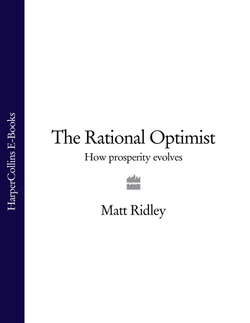Читать книгу The Rational Optimist: How Prosperity Evolves - Matt Ridley, Matt Ridley - Страница 10
Cheap light
ОглавлениеThese richer, healthier, taller, cleverer, longer-lived, freer people – you lot – have been enjoying such abundance that most of the things they need have been getting steadily cheaper. The four most basic human needs – food, clothing, fuel and shelter – have grown markedly cheaper during the past two centuries. Food and clothing especially so (a brief rise in food prices in 2008 notwithstanding), fuel more erratically and even housing has probably got cheaper too: surprising as it may seem, the average family house probably costs slightly less today than it did in 1900 or even 1700, despite including far more modern conveniences like electricity, telephone and plumbing. If basic needs have got cheaper, then there is more disposable income to spend on luxuries. Artificial light lies on the border between necessity and luxury. In monetary terms, the same amount of artificial lighting cost 20,000 times as much in England in the year 1300 as it does today.
Enormous as that difference is, in labour terms the change is even more dramatic and the improvement is even more recent. Ask how much artificial light you can earn with an hour of work at the average wage. The amount has increased from twenty-four lumen-hours in 1750 BC (sesame oil lamp) to 186 in 1800 (tallow candle) to 4,400 in 1880 (kerosene lamp) to 531,000 in 1950 (incandescent light bulb) to 8.4 million lumen-hours today (compact fluorescent bulb). Put it another way, an hour of work today earns you 300 days’ worth of reading light; an hour of work in 1800 earned you ten minutes of reading light. Or turn it round and ask how long you would have to work to earn an hour of reading light – say, the light of an 18-watt compact-fluorescent light bulb burning for an hour. Today it will have cost you less than half a second of your working time if you are on the average wage: half a second of work for an hour of light. In 1950, with a conventional filament lamp and the then wage, you would have had to work for eight seconds to get the same amount of light. Had you been using a kerosene lamp in the 1880s, you would have had to work for about fifteen minutes to get the same amount of light. A tallow candle in the 1800s: over six hours’ work. And to get that much light from a sesame-oil lamp in Babylon in 1750 bc would have cost you more than fifty hours’ of work. From six hours to half a second – a 43,200-fold improvement – for an hour of lighting: that is how much better off you are than your ancestor was in 1800, using the currency that counts, your time. Do you see why my fictional family ate by firelight?
Much of this improvement is not included in the cost-of-living calculations, which struggle to compare like with unlike. The economist Don Boudreaux imagined the average American time-travelling back to 1967 with his modern income. He might be the richest person in town, but no amount of money could buy him the delights of eBay, Amazon, Starbucks, Wal-Mart, Prozac, Google or BlackBerry. The lighting numbers cited above do not even take into account the greater convenience and cleanliness of modern electric light compared with candles or kerosene – its simple switching, its lack of smoke, smell and flicker, its lesser fire hazard. Nor is the improvement in lighting finished yet. Compact fluorescent bulbs may be three times as efficient as filament bulbs in turning electrons’ energy into photons’ energy, but light-emitting diodes (LEDs) are rapidly overtaking them (as of this writing LEDs with ten times the efficiency of incandescent bulbs have been demonstrated) and have the added benefit of working at a portable scale. A cheap LED flashlight, powered by a solar-charged battery, will surely soon transform the life of some of the 1.6 billion people who do not have mains electricity, African peasants prominent among them. Admittedly, LEDs are still far too expensive to replace most light bulbs, but that might change.
Think what these improvements in lighting efficiency mean. You can either have a lot more light, or do a lot less work, or acquire something else. Devoting less of your working week to earning your lighting means devoting more of it to doing something else. That something else can mean employment for somebody else. The improved technology of lighting has liberated you to make or buy another product or service, or do a charitable act. That is what economic growth means.
